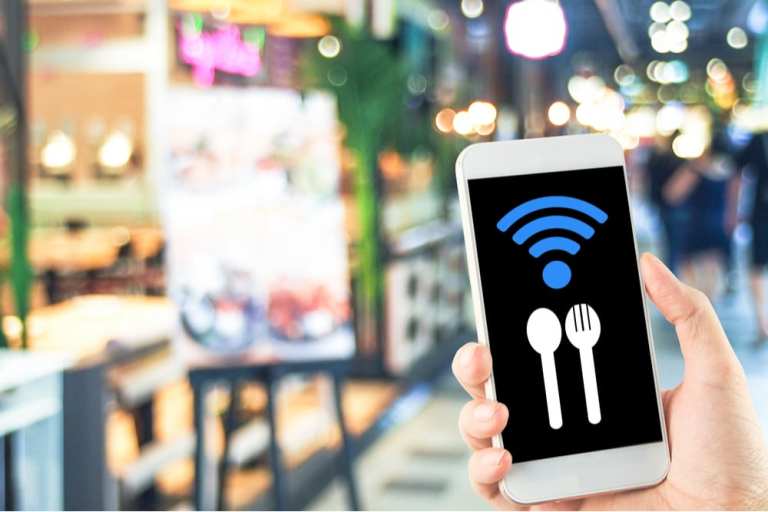
To help diners make the best use of their mobile devices to order meals, quick-service restaurants (QSRs) are tapping into mobile innovations. Technology that lets diners place their orders for pickup or delivery has become more common, and mobile devices are serving more restaurant functions than they have in the past.
According to the latest PYMNTS Mobile Order-Ahead Tracker, “Mobile order-ahead has become ubiquitous to QSRs and nearly every chain now has an app presence, making it easy to forget that the technology was rare just 10 years ago.” Domino’s was one of the original restaurant chains to drive disruption with the development of an online tracker.
From Dunkin’ Brands to Grubhub, QSRs and ordering platforms are driving innovation with mobile ordering technology. Here are just a few of the ways these types of companies are making it more convenient for diners to order ahead:
The portion of restaurant apps that offered mobile order-ahead as of April 2019 was 18 percent. QSRs are expanding their mobile order-ahead capabilities. Dunkin’ Brands, in one case, opened up its digital ecosystem in the fourth quarter by letting any diner use its on-the-go mobile ordering, a feature that was exclusive to DD Perks members in the past. Now, the company allows any customer to place an order and earn points through their preferred payment method. In the fourth quarter, the company processed more than 20 million on-the-go orders, which Dunkin’ Brands CEO Dave Hoffmann called “a new milestone.”
The share of Americans who prefer ordering takeout or delivery to eating on-premises is 34 percent. At the same time, retailers are testing out new store designs to accommodate those trends. Chipotle Mexican Grill has begun to pilot multiple formats, including one with a walkup window across from Wrigley Field. The 2,000-square-foot restaurant has a diner-facing grab-and-go beverage case and digital pickup shelves close to the front door, among other features. In the fourth quarter, the restaurant chain reported skyrocketing digital sales of 78.3 percent. It also opened 80 new restaurants, with the inclusion of one relocation, and shuttered three locations.
The year-over-year increase in food and beverage industry fraud attacks reported in 2018 was 79 percent. Food delivery companies are teaming with payment platforms to provide secure payment experiences to customers. An important benefit of the tie-up is the ability to take on increasing scenarios of card testing and levels of card-not-present fraud in the eCommerce food delivery space. Evan Li, chief information officer for food delivery company Easi, said in an announcement, “We know that online food delivery is one of the industries fraudsters focus on, and that’s why we’ve been working with Adyen to use a combination of machine learning and risk rules-based technology to help us to reduce the risk.”
The share of consumers who fear that using mobile ordering apps will lead to payments fraud is 49 percent. As QSRs revamp their businesses for app ordering, scammers have focused on this space. Safety solutions company Sift asked consumers about their concerns concerning digital dining and found that almost half – or 49 percent – of respondents are worried that payments fraud will result from QSR app use. A slightly fewer share – 41 percent – are worried that dining apps might cause an account takeover (ATO). Twelve percent fear their rewards and points might be tampered with, while 37 percent of customers surveyed would drop a QSR brand permanently if a fraud event happened.
The increase in the popularity of cauliflower crust pizza orders on Grubhub from 2018 to 2019 was 650 percent. Grubhub also rolled out expanded perks for mobile customers, with exclusive offers available on the platform in addition to new ways to earn and redeem restaurant loyalty rewards. Perks can be accessed via a tab at the bottom of the screen in the Grubhub and Seamless mobile apps. Matt Maloney, Grubhub founder and CEO, said in a press release at the time, “Restaurants have always used free food as a perk for their VIP diners, to keep them happy and coming back. We have now extended this practice to Grubhub diners by building loyalty tools so our restaurant partners can promote their restaurants more aggressively on our marketplace and reward their best digital diners as well.”
From Grubhub to Chipotle Mexican Grill, technology providers and QSRs are making it easier for consumers to order their favorite foods using order-ahead technology. And even some unexpected players are dipping their toes into mobile ordering: Air Asia recently rolled out a restaurant that serves the airline’s signature dishes with the help of mobile ordering technology.